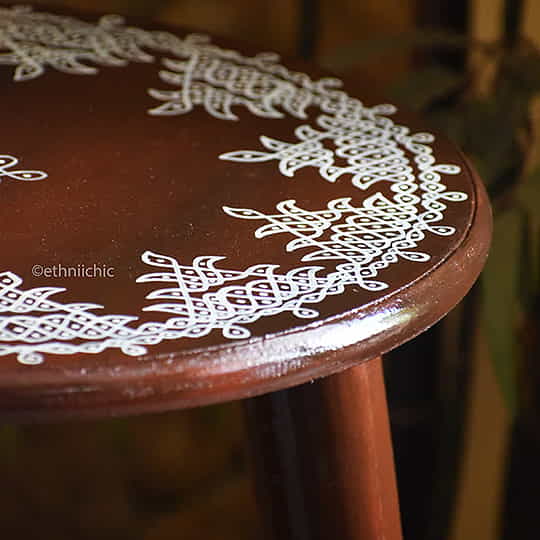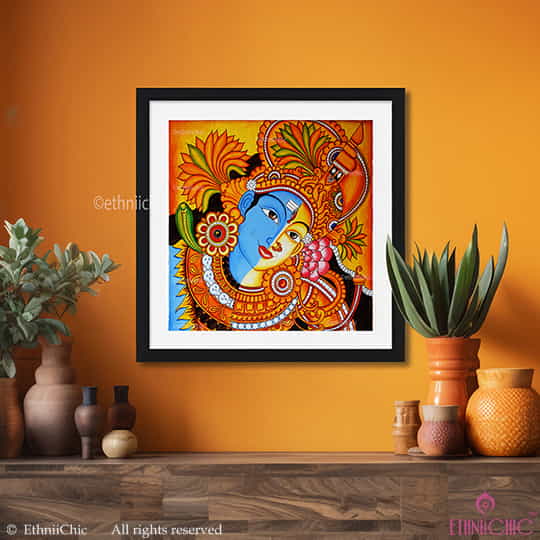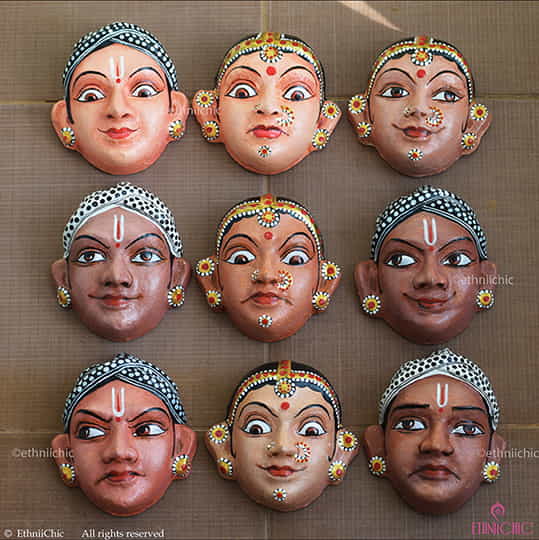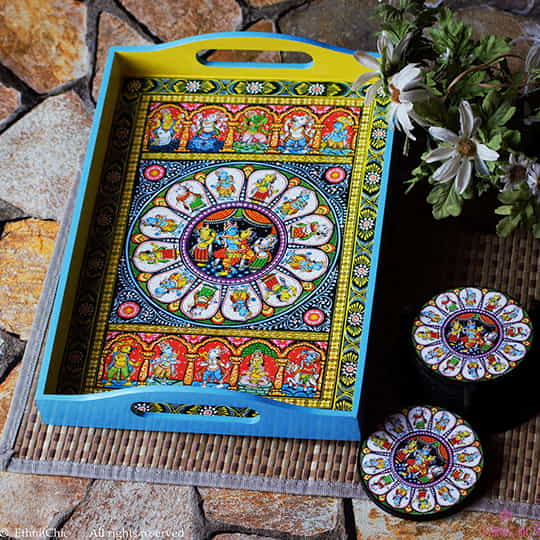Explore the vibrant world of Pattachitra—an ancient art form from Odisha and Bengal, united in heritage yet distinct in style, color, and storytelling. This blog delves into their unique expressions and enduring traditions.
It was a quiet afternoon in the coastal village of Raghurajpur, Odisha, the air thick with the scent of tamarind trees and the earthy aroma of wet terracotta. As I walked through the narrow lanes, every corner whispered stories of color, myth, and tradition. A soft rustling came from a small hut where an elderly artist sat, hunched over a canvas, his fingers dancing gracefully, painting gods and goddesses in vivid hues. “Pattachitra,” he said with a warm smile, gesturing towards his work. “The scrolls of devotion.”
A few months later, I found myself in the heart of West Bengal, in a village near Naya in Pingla, where music and paint coalesced in a beautiful synergy. A group of artists, known as patuas, sang melodious tales of gods and social messages while unrolling their hand-painted scrolls. Their Pattachitras, too, were vibrant and divine, yet something about them felt different.
This journey into the world of Pattachitra unfolded not just as an exploration of art but of identity, culture, and storytelling. Both Odisha and Bengal have nurtured this traditional art form for centuries, yet their expressions diverged in enchanting ways.
The Shared Roots: A Common Canvas of Devotion
Before we dive into the contrasts, it’s important to appreciate what binds the Odisha and Bengal Pattachitra traditions. Both are forms of narrative painting, rooted in the Sanskrit words “patta” (cloth) and “chitra” (picture). They depict religious themes, often centered around Hindu deities such as Jagannath, Krishna, and Rama, and are used in temple rituals, festivals, and storytelling traditions.
Both styles are intricate, colorful, and made using natural dyes. The artists traditionally prepare their own canvas by stiffening cloth with a mixture of chalk and gum, then polish it with stones for a smooth painting surface. The stories painted are often accompanied by songs or chants and passed down through generations within families dedicated to the art.
Yet, within these similarities, the cultural flavor of each region breathes its uniqueness into the scrolls.
Odisha Pattachitra: The Divine Chronicle
In Odisha, the Pattachitra tradition is deeply entwined with the Jagannath cult of Puri. Its origin can be traced back over a thousand years to the rituals of the Jagannath Temple. During the fifteen-day period of the deity’s ritual bathing (Snana Yatra), when the idols are kept away from public view, Pattachitras are displayed as substitutes for darshan.
The Odisha Pattachitras are known for their fine detailing, disciplined structure, and mythological narratives. The figures have a distinctive stylization—elongated eyes, sharp features, and a certain geometrical precision. The paintings are bordered ornately, and the use of red, yellow, white, and black dominates the palette.
Themes revolve around Vaishnavism, especially stories from the life of Lord Jagannath, Radha-Krishna, Ramayana, Mahabharata, and other Puranic tales. The chitrakars (painters) work with a strong sense of devotion, their brush strokes almost like prayer.
Bengal Pattachitra: The Singing Scroll
In contrast, Bengal’s Pattachitra—also called Pat or Patua art—blends painting with performance. Here, the scrolls are longer and often unfolded vertically while the artist sings the story, known as poter gaan. It is a living storytelling tradition, vibrant and mobile.
The Bengal style originated around the 13th century and flourished especially in regions like Medinipur, Birbhum, and Bardhaman. Unlike the temple-centric Pattachitras of Odisha, Bengal’s scrolls traverse a broader range of themes. While gods and goddesses remain central, many scrolls address social issues, folktales, and even contemporary events like natural disasters or political commentary.
Visually, Bengal Pattachitras are more fluid and expressive. The figures have rounded faces, soft expressions, and the use of space is freer. The borders are often simpler or even absent. The color palette is equally vibrant but with more liberal use of blue and green shades. Artists sometimes use homemade ink or natural pigments sourced from local plants and minerals.
How to Recognize the Difference: A Collector’s Eye
So, how does one distinguish an Odisha Pattachitra from a Bengal Pattachitra at a glance?
- Material and Presentation:
- Odisha Pattachitras are usually painted on cloth, dried palm leaves, or Tussar silk. They are more often framed or used as wall hangings.
- Bengal Pattachitras are usually scrolls meant to be unrolled vertically. They are designed for storytelling performances, often carried from village to village.
- Artistic Style:
- Odisha’s style is more rigid and symmetric, with detailed borders and geometrical patterns. It’s rooted in temple art.
- Bengal’s style is narrative-driven, more folk-like in expression, and dynamic. The brush strokes are freer, reflecting oral storytelling.
- Subject Matter:
- Odisha primarily focuses on divine and mythological stories related to Jagannath and Vaishnavite themes.
- Bengal includes both religious themes and social narratives—ranging from myths to contemporary issues.
- Color Palette:
- Odisha employs a more restricted palette with dominant reds, yellows, and blacks.
- Bengal artists use brighter and more diverse colors, often incorporating greens and blues.
- Performance Element:
- Odisha Pattachitra is silent—meant for visual meditation.
- Bengal Pattachitra is musical—each scroll comes alive through the poter gaan.
Beyond the Paint: Living Traditions in Changing Times
While both forms are traditional, they have also evolved with time. Odisha’s chitrakars have started experimenting with new themes and formats, catering to a wider market including tourists and online buyers. Bengal’s patuas, on the other hand, continue to innovate through their songs, often addressing current issues like climate change, health awareness, and political satire.
Art schools and cultural organizations are now helping revive and preserve both forms. Workshops, exhibitions, and digital platforms have given these artists new life. The pandemic, for example, saw many Bengal patuas taking to social media, sharing their scrolls and songs to raise awareness about COVID-19.
The Heart of the Scroll
As I sat with a patua in Bengal, watching him sing a tale of Goddess Durga slaying Mahishasura, I was struck not just by the art but by its soul. Days later, sitting in the verandah of an Odisha chitrakar’s home, watching him paint the Rath Yatra, I felt the same reverence.
Though the styles, songs, and scrolls may differ, the heartbeat of both Pattachitra traditions is the same—a devotion to storytelling, a reverence for heritage, and an artistry that refuses to fade with time.
In a world racing toward the digital, these painted scrolls remind us of the beauty of the handmade, the power of oral traditions, and the enduring legacy of our roots. Whether from Odisha or Bengal, each Pattachitra is a window into a culture that still sings, still prays, and still paints stories that have lived for centuries—and will, undoubtedly, live on.





